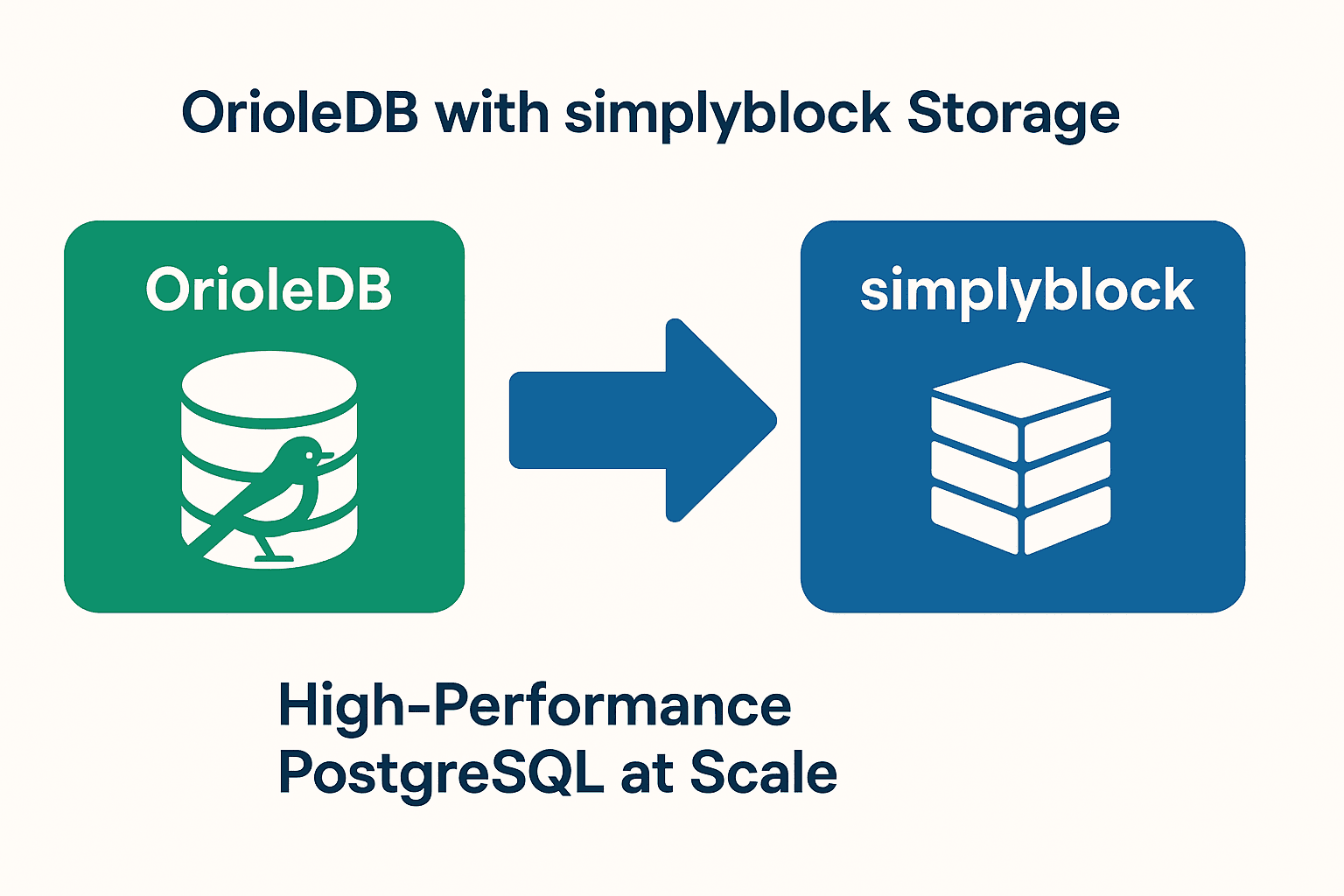OrioleDB is a next-generation storage engine for PostgreSQL, designed to fix long-standing pain points in traditional Postgres. It improves concurrency, reduces bloat with smarter vacuuming, and speeds up crash recovery, making PostgreSQL better suited for modern workloads. However, OrioleDB’s performance depends heavily on storage, even with these enhancements.
Without fast and resilient volumes, query times can increase, replication lag can occur, and failure recovery can slow down. Simplyblock provides the high-performance foundation that allows OrioleDB to deliver consistent results in both on-prem and hybrid multi-cloud storage environments.
Why Storage Matters for OrioleDB
OrioleDB brings powerful improvements like better concurrency, background vacuuming, and efficient checkpoints. These features let PostgreSQL handle heavier workloads, but they also place more demand on the underlying storage system.
If storage is slow or tied to a single zone, OrioleDB’s benefits are quickly undermined. Issues like WAL latency, replication delays, and unpredictable recovery can surface. By running OrioleDB on simplyblock, administrators ensure database performance with predictable throughput and reliable availability.
🚀 Use Simplyblock with OrioleDB for Resilient PostgreSQL Performance
👉 Deploy OrioleDB on simplyblock volumes for consistent speed and failover-ready clusters.
👉 Use simplyblock for Database Branching
Step 1: Provisioning Simplyblock Volumes for OrioleDB
Start by creating and attaching simplyblock volumes for OrioleDB data and WAL files:
sbctl pool create orioledb-pool /dev/nvme0n1
sbctl volume add orioledb-data 150G orioledb-pool
sbctl volume connect orioledb-data
Format and mount the volume:
mkfs.ext4 /dev/nvme0n1
mkdir -p /var/lib/orioledb
mount /dev/nvme0n1 /var/lib/orioledb
Persist the mount in /etc/fstab:
/dev/nvme0n1 /var/lib/orioledb ext4 defaults 0 0
This ensures OrioleDB always uses simplyblock-backed volumes for data durability. For a deeper understanding of how OrioleDB improves storage efficiency and performance, refer to the OrioleDB Documentation – Storage Engine & Performance.

Step 2: Configuring OrioleDB to Use Simplyblock Storage
Point OrioleDB to the mounted simplyblock directory for data and WAL. Update PostgreSQL configs (since OrioleDB is a Postgres extension):
In postgresql.conf:
data_directory = ‘/var/lib/orioledb/data’
wal_directory = ‘/var/lib/orioledb/wal’
Restart PostgreSQL to apply:
sudo systemctl restart postgresql
With this setup, OrioleDB’s advanced storage engine runs fully on simplyblock volumes, giving consistent low-latency performance and helping teams simplify data management.
Step 3: Scaling OrioleDB Volumes for Growth
As workloads grow, OrioleDB databases can outpace their initial storage allocations. With simplyblock, volumes can be resized live, without downtime:
sbctl volume resize orioledb-data 300G
resize2fs /dev/nvme0n1
No migrations or restarts are required. OrioleDB continues to process transactions while storage expands in the background. This makes it easier to handle growth across multi-cloud environments without operational slowdowns.
For detailed configuration and code examples on handling OrioleDB scaling and storage optimizations, check out the OrioleDB GitHub Repository.
Step 4: Multi-Zone Resilience for OrioleDB Clusters
OrioleDB clusters deployed across availability zones often face downtime if their storage is locked to a single zone. With simplyblock’s zone-independent volumes, storage remains available even during node rescheduling or failover.
This aligns with best practices for disaster recovery, as outlined in the PostgreSQL High Availability Guide, ensuring minimal downtime and reliable data recovery.
Step 5: Replication with Simplyblock
For maximum durability, combine OrioleDB’s built-in replication with simplyblock’s storage-level replication:
sbctl volume replicate orioledb-data –zones=zone-a,zone-b
This setup provides:
- Lower RPO (Recovery Point Objective) → minimal data loss.
- Lower RTO (Recovery Time Objective) → faster recovery after failures.
By integrating replication at both the database and storage levels, OrioleDB gains enterprise-grade resilience. This mirrors broader fast backups and disaster recovery strategies while supporting the reduction of RPO and RTO in mission-critical systems.
Scaling OrioleDB Workloads Reliably with Simplyblock
OrioleDB upgrades PostgreSQL with features that make it more efficient and scalable, but its true potential can only be realized with the right storage. Simplyblock ensures OrioleDB runs smoothly by eliminating I/O bottlenecks, reducing recovery times, and keeping workloads highly available.
With NVMe-over-TCP, zone-independent volumes, and seamless scaling, Simplyblock provides the storage backbone for production-grade PostgreSQL. It also supports disaggregated storage architectures and simplifies migration from Amazon RDS to PostgreSQL.
Questions and Answers
You can run OrioleDB as a PostgreSQL extension on top of simplyblock’s NVMe-over-TCP storage volumes. Using sbctl, you provision fast, resilient block devices for WAL and data directories. This ensures consistent performance and enables scalable PostgreSQL deployments across both on-premises and cloud environments.
Yes, Simplyblock enables zone-independent volumes and replication across availability zones. This ensures OrioleDB remains highly available during node rescheduling or failover. Combined with OrioleDB’s replication, it supports low RTO and RPO objectives in production environments
Absolutely. Simplyblock allows live volume resizing without downtime or restarts. You can expand OrioleDB’s data volumes while the database is running, ideal for dynamic workloads or cloud-native PostgreSQL clusters that require elastic storage scaling.
OrioleDB benefits from simplyblock’s low-latency NVMe-over-TCP volumes, optimized for high IOPS and predictable throughput. This reduces WAL lag and crash recovery times, helping to eliminate I/O bottlenecks and optimize PostgreSQL performance.
Yes. Simplyblock provides disaggregated storage with flexible volume management across zones and clouds. This lets you run OrioleDB in hybrid environments with consistent performance, making it easier to migrate from solutions like Amazon RDS or manage state across regions.

